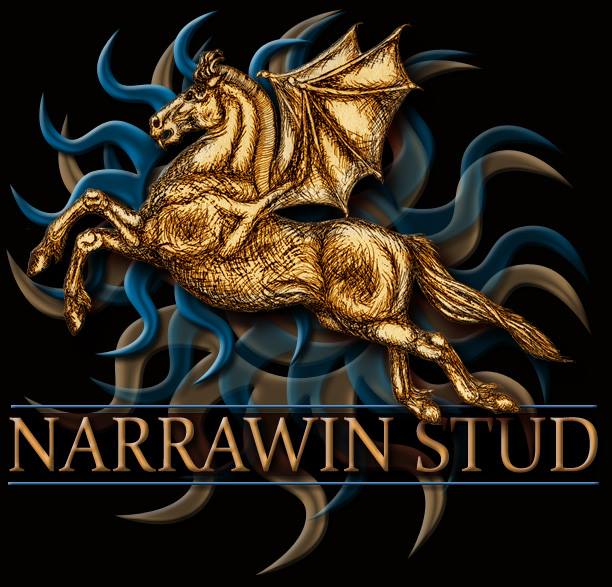In principle, all horses are gaited, since they propel themselves forward by using their legs in a coordinated fashion.
However, the term Gaited Horses (Also: “Gangpferd” in German, “Paso” in Spanish - meaning step) refers to those horses who have gaits in addition to the usual walk, trot and canter. Some breeds are so “gaited” that they don’t trot.
The perfect “gait” has been defined as an isochronal four beat. That means that there is the same amount of time between each foot stiking the ground. The footfall pattern of the Gaited Horse in ‘gait’ is the same as any horse in the walk: left hind, left front, right hind, right front, left hind, left front…. etc. However, Gaited Horses can maintain that rhrythm at far faster speeds than a walk. Most perform best at a medium speed, so traditionally, the ‘gait’ replaces the trot. So gaited horses walk, ‘gait’ and canter. Some gaited breeds have retained the ability to trot, and are traditionally ridden and shown in trot and gait (for example, American Saddlebred and Icelandic Horses). In other breeds, the gait completely replaces the trot (Paso Fino, Peruvian Horse, Tennessee Walker and others). Yet again, in other breeds, the goal is to let the horse work in an imperfect gait. Instead of an isochronal 4-beat, a biased 4-beat is wanted. Think of it as halfway between a trot (diagonal two-beat), and an even-timed four-beat. Instead of hearing a ta-ca-ta-ca-ta-ca.. (isochronal), you hear ta—ca-ta—ca-ta—ca… This is the foxtrot in the Missouri Foxtrotter and and the Trocha in the Paso Fino. Is it quite as smooth as a perfect four-beat? No. But it is stll a lot smoother than a trot!
Likewise, it is possbile to have a horse deviate from the perfect four-beat not towards the trot, but towards the pace (lateral two-beat). This is sometimes seen in very strongly gaited breeds that have “lost” the trot. In Peruvian Horses, it is called Sobreandando. As pacing horses are not only bouncy but also move the riders hips sidewise, it is not a preferred riding gait, and while a pacey gait is still better than a pace, it is considered undesirable in most gaited breeds. It is often an indication of tension in a horse, insufficient training, lack of suppleness, or if they are tired or lazy, and it can be tough to correct.
Several years ago, Swedish researchers located the gene responsible for gait patterns. The gene for gait is a mutation , which results in changes to the way muscles fire in the spine. This has been commercialised as a genetic test for any horse under the name “Gaitkeeper”. There is still more to be discovered, as the same mutation is also found in some strong trotting breeds, such as French Trotters and Orlov (Russian) Trotters. However, all gaited breeds show the mutation, and having tested numerous horses from different gaited breeds as well as some crossbreds (other parent non-gaited), the test always confirmed my observations and expectations.
Another term often used to refer to these “other gaits” is “saddle gaits”, as they are comfortable for riders. Such horses have been known and bred and prized for a long time. The term “ambling” has latin roots and ambling horses were clearly described. Throughout the dark ages and middle ages, ambling palfreys were the mounts of choice for nobility, ladies, the well to do, and any man who didn’t want or need to ride their destrier (war horse). As roads improved, the need for smooth riding horses lessened, and many were shipped off to the Americas. There, the tough terrain, the demands of the people riding them, and the range of climatic zones they had to survive in, formed several breeds of Gaited Horses. Europe lost most of the gaited genetics.
In many other parts of the world, gaited horses and mules continued to be used and bred, and are still around to this day. North Africa has gaited horses, mules and donkeys, and in the south of the continent, there are Basuto Ponies and Cape Horses. Greece has Arravanis, and there are speedy Gaited Horses in Turkey and other countries in the region. There are many other not so well known breeds, which are well gaited in Asia. Europe has seen the re-discovery of Gaited Horses, which started with the importation of Icelandic Horses some years after WWII, and subsequently saw an enthusiastic community of riders and breeders import Gaited Horses from all over the world. I recall visiting Equitana in Essen in 1971, and seeing Peruvian Horses for the first time. With other words, Gaited Horses really are not rare at all.
Unfortunately, Australia was settled at a time when Europe and Great Britain had lost most Gaited Horses, so aside from the occasional accidental one, or the rare importation of a couple of Icelandic Horses in Australia’s early history, it wasn’t until the 1970’s that Gaited Horses started arriving here. Inititally, there were American Saddlebreds and Peruvian Horses. Some after, a group of Icelandic Horses arrived. Then Tennessee Walkers, and in 2000, the first Paso Finos. Since then, Rocky Mountain Horses and Missouri Foxtrotters have arrived. Additionally, many pacing Standardbreds have been found to be retrainable to amble under saddle, and of course, there are crossbred horses, many of which have inherited the ability to gait.
